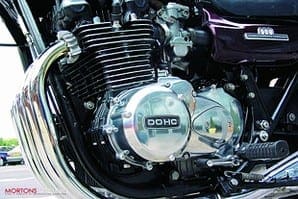
Third and final part of Rod Gibson's Kawasaki Z1 engine rebuild. Captions are reproduced in full below but for step-by-step captions and images, visit the image gallery.
Picture one: Last month I fitted the crank, input shaft and clutch basket into the upper crankcase half. Before joining the cases I’m refitting the gearbox output shaft. There’s no need to strip the gears from the shaft for inspection unless there’s an obvious problem with an individual bearing – the teeth and selector dogs on the gears can be easily seen. This bike has clearly had a relatively easy life and the gearbox components look like new.
Picture two: Likewise the kickstarter mechanism, which is also in mint condition. Note the ratchet drive on the right-hand end of the shaft. If in any doubt about the condition of the ratchet spring, this is the time to replace it, before the crankcases get bolted up. The ratchet tag needs to locate below the stop plate bolted to the crankcase, and the bearing has a hole that locates on a pin in the casing. It’s almost impossible to get this in wrong, but make sure it does turn and engage correctly before proceeding.
Picture three: The centre main bearing cap locates over the crankshaft and bolts down. At this point I’m double-checking to make sure all the main bearings are correctly located on their dowel pins in the casing; a misaligned pin can be forced through the casing, cracking it as the cases are bolted up. The pins also make sure the oil feed holes in the bearings are correctly aligned with their drillings in the crankcase – never be tempted to miss out a dowel pin or the bearing will be starved of oil. Note the camchain in place on the crank; if you’ve forgotten to fit it, do it now!
Picture four: All the shafts are now in place in the upper crankcase, all the bearings are correctly located into their housings and all dowel pins and locating rings are present, correct, and engaged. Time, then, to join up the cases. I use a thin smear of Blue Hylomar on the jointing face before offering the lower crankcase half to the upper. The three selector forks need to hook over their respective gears as the casing goes on, and a little jiggling might be required to make sure they’re correctly engaged. Note also there’s a rubber O-ring between the crankcase halves; you can see it here just aft of the centre main bearing cap. This isn’t listed in the parts list, and should be replaced with a new one; the part number is 92055 048.
Picture five: Here you can see the selector forks in their gear tracks. It doesn’t matter too much which gear is selected at this stage, so long as everything is engaged correctly together. I can then gently tap the crankcases together with a soft rubber mallet, ensuring the front and rear dowels engage and the crankcases meet up evenly. I then drop a couple of bolts in and wind them in finger-tight, and pause to make sure all the shafts rotate correctly before finally fitting and torqueing all the crankcase bolts down in sequence. There are 22 M6 bolts and eight M8 bolts in all, the larger diameter bolts locating the main bearings. Check the shaft rotation after torqueing down, too, and double back a step if in any doubt.
Picture six: Next is the oil pump. Again, this checks out fine, and I’ve given the strainer gauze a good scrub before offering up the pump to the lower crankcase half. The pump locates on two dowels fitted to two of the three M6 mounting bolts, with an O-ring sealing the pump to the crankcase casting. Next the strainer gauze fits on the pump intake where three M5 panhead screws hold it on. I always use a drop of Loctite blue on these screws to prevent them coming loose in service.
Picture seven: Then it’s a new sump gasket, and the sump drops on the lower crankcase half and gets bolted up. I’ve greased the gasket to help it settle, and I can torque the sump bolts down diagonally to prevent any warping. Note that some of these bolts have cable clips attached to locate the points wiring. These clips are best replaced in their original positions, but can be added later if necessary. Note also that there’s a large O-ring sandwiched between the sump and the crankcase, fitted in a groove around the oil filter housing. I’ve used a little silicone sealant to stop this falling out as I fit the sump.
Picture eight: I’m working alone here, so I’ve opted to fit the engine into the rolling chassis while it’s still a manageably small unit, and light enough to manhandle alone. I have to say, though, that an assistant would be useful, and I’d recommend drafting in a mate for this bit if you can. I wrapped and taped old bits of cardboard around all the frame tubes before lifting the engine in from the right-hand side of the bike to avoid scratching the frame. Once it’s in, I’ve seated it on this extremely useful Handy Industries jack, which I can wind up and down to line up the holes for the mounting bolts, slotting them all in, one at a time, until the complete set is fitted. There are removable engine plates at the front right and at both sides of the upper rear mountings, and two small engine plates at each side of the engine on the frame bottom rails, located with egg-shaped captive nuts. With all the plates, spaces, nuts and bolts fitted, I can go round tightening everything up.
Picture nine: Now I can crack on and get the lower end rebuilt. First off, the gear selector claw hooks into the left side of the crankcase. Reassembling this area first means I can check gear selection and satisfy myself it’s working correctly, and I’m aiming to get the rear chain fitted as soon as possible to give me something to tighten the clutch centre and alternator nuts against later.
Picture 10: The gear selector mechanism is hidden beneath this ‘mission cover’. Note the new, greased, gasket. The mission cover has three oil seals fitted, one each for the output shaft, the gear-change shaft and the clutch pushrod. I’m using a squirt of ACF50 on each seal to help ease them into their housings by hand, and to lubricate the seal lips to stop them snagging on the shafts as the mission cover goes on. Finally I can fit the panhead screws, and tighten them diagonally.
Picture 11: At the top of the crankcase this cylindrical housing covers the oil separator for the crankcase breather. Kawasaki made great shakes of this design at the time of the bike’s launch, and it’s a forerunner of the environmentally concious recycling systems that were to come on later designs. Clean air from the crankcase exits the breather housing through a single pipe at the top which, in turn, connects to the air filter, where it is drawn into the engine and burned, reducing emissions further. An O-ring seals the housing against the crankcase. Note the superb-looking alloy polishing, which will contrast superbly with the satin black powder coating on the crankcase.
Picture 12: At the right front of the engine I’m now refitting the inner points housing. This also has a new gasket and an oil seal, which I’ve again fitted with a squirt of ACF50. The housing locates on two dowel pins, and fixes down with six new M6 panhead screws. Note the upper dowel pin in the crankcase, visible below the top centre screw hole.
Picture 13: At this stage I’m reducing the pile of bits on the bench, so any larger components that can be simply bolted up get fitted. This is the starter motor, sliding into the top of the crankcase and fitting into the back of the generator housing from the back. There’s an O-ring on the starter motor boss; make sure this is in good condition or the engine will leak oil from the back of the generator housing, running down behind the engine sprocket cover and making the source difficult to track down. Two M5 bolts hold the starter motor to the crankcase.
Picture 14: Next at the top of the pile is the clutch. This follows what I’d now recognise as conventional Japanese design, the inner drum bolting up to the end of the input shaft before the plates go back in, alternating seven plain steel with eight friction plates. There’s a plain thrust washer fitted behind the clutch drum; the one on this engine had been mysteriously hand-made with a raggedy-shaped hole hand-filed in the middle. Someone has obviously tinkered with the clutch before, but everything seems to be in order and the plates still have plenty life left in them. With the lifter mushroom in place, not forgetting the 3/8" ball bearing fitted behind it, the pressure plate goes on with the five springs and their M6 bolts, and I can refit the clutch cover with a new gasket.
Picture 15: With the pile of bits rapidly reducing on the bench, I'm opting to refit the points backplate next. I scratched tiny reference marks on the backplate so I have a starting-point for the ignition timing, but I’ll be setting the points up and strobing the ignition once the bike is fully rebuilt. Many owners would choose to replace the ignition system with an after-market electronic kit but, in view of the budget for this job, we’ve opted to postpone that option for later. The bike will be perfectly healthy running on points ignition so long as they’re correctly adjusted.
Picture 16: On the Z1 engine, the main oil feed for the crankshaft main bearings is taken from a large-diameter gallery running across the engine, behind the barrels. This also provides a feed for the cam bearings. To transfer oil from the pump to the gallery, Kawasaki designed this bolt-on block that clamps to the top of the crankcase with M6 panhead screws. Note the O-ring at each jointing face. The nylon switch body at the top of the block is the oil pressure switch, a convenient place for the designer to put it. With no pressure in the system, the plunger on the switch rests against the crankcase, earthing the circuit to light the warning lamp. Oil pressure pushes the plunger off the crankcase, breaking the circuit and extinguishing the light.
Picture 17: Next I’m going to fit the generator and starter clutch to the left-hand end of the crankshaft. A phosphor bronze thrust washer fits outboard of the left main bearing, followed by this needle roller bearing on the crank itself. This bearing provides support for the starter drive gear, and I’ve oiled it with clean, fresh engine oil before fitting the starter clutch and rotor assembly. The rotor itself fits on the crank taper, and I usually take the precaution of gently lapping the rotor to the crank to make sure the taper is sound and the rotor can’t come loose in service.
Picture 18: The starter clutch bolts to the back of the rotor with three Allen head screws. These were trouble-free on the Z1 series, but a constant source of problems with Kawasaki’s Z750 twin, on which they would shake loose, followed by total destruction of the starter clutch and generator. Some GSX Suzukis suffered from similar problems, and Yamaha XV535 twins were afflicted by the same fault until quite recently. Inside the starter clutch body are these rollers, each engaged in a slot by a spring-loaded pin and spring.
Picture 19: The easiest way to refit the starter clutch and rotor is to firstly engage the drive gear into the back of the starter clutch housing, gently rotating and pushing until the drive gear boss drops into the rollers. Then, holding it all together, I can position the assembly over the end of the crankshaft, over the bearing I fitted at step 17, and slide it home on the taper. A single bolt and washer clamps the whole thing to the end of the crank, and I always use a spot of Loctite blue on the bolt threads before torqueing it down.
Picture 20: Also in the generator casing is the starter reduction gear. This fits between the end of the starter motor and the starter clutch drive gear, and transmits the drive from the motor to the engine. When the engine fires, the crank is spinning faster than the starter motor, so the freewheeling action of the starter clutch prevents damage to the starter motor. The reduction gear also serves to gear down the output from the starter motor, making its power delivery more able to spin the engine. The spindle is best slid into the gear once the teeth are engaged, and there’s a plain thrust washer each side of the reduction gear.
Picture 21: With both sides of the engine now completed, I can turn my attention to the top end. Having first fitted a new front slipper blade into the camchain tunnel on the cylinder barrels, I’ve refitted the central camchain idler wheel into the crankcase mouth, between the two chain runs, and hoisted the cam chain upwards through the barrels, tying it off with an old piece of electrical wire. Note the dowels on the cylinder studs that carry the oil feed to the cams, and the fresh, greased base gasket. Now, with the engine positioned at 2&3 TDC, I can gently lower the barrels and engage the two centre pistons. Once their rings are engaged, I can gently turn the engine, lowering the barrels and centre pistons and engaging the two outers as they rise to meet the barrels. With all four pistons engaged, I can gently tap the barrel down evenly until it fits into the crankcase mouth, then turn the engine while supporting the camchain to make sure the pistons move correctly in their bores.
Picture 22: At the top of the barrels, two roller sprockets guide the camchain on its run. The rear sprocket also carries the pivoting arm and rubber wheel for the camchain tensioner. Both sprockets drop into recesses in the top of the barrels, and then have small rubber blocks fitted to dampen them. Note the rubber blocks are marked ‘TOP’, and must go the right way up.
Picture 23: The early Z1 was a pretty good design, but wasn’t without its teething troubles. One item Kawasaki were quick to modify was the one-piece cylinder head gasket, notorious for incurably weeping oil from the front of the camchain tunnel. From engine number Z1E-14319 this was modified to a two-piece design, a separate moulded O-ring taking up residence in a new groove machined for the purpose around the top of the camchain tunnel. Our bike is an early model, and I’m hoping this new gasket won’t cause any problems with weepage. The one-piece gasket isn’t easy to find now, and isn’t cheap at over £60.
Picture 24: Timing the cams is fairly easy: with the engine set at 1&4 TDC, there are simple reference marks on the camwheels that line up to the cylinder head face. Once timed, I refit the top idle sprocket, followed by the camchain tensioner, and I can tension up the camchain. Finally I rotate the engine several times, checking the cam timing is spot-on.
Picture 25: Now, at last, I can shim up the engine. Turning the engine over by hand, I can measure what clearances I have on which valves, keeping a chart to work from. Then, one at a time, I can remove the shims and calculate what sizes I need to fit to bring the valve clearances into the correct adjustment. This, of course, involves ordering shims, which means another week’s delay before I’m able to start up the engine.
Once the engine is fired up, I can then check it over for oil leaks and strobe the ignition timing before taking it out on a test run. I’ll be recommending a running-in procedure as if the bike were new, and a full engine service and oil change at 500 miles, along with a shim check and carb and ignition adjustment. The bike should then be good as new, with a finish that will dazzle concours judges and keep its good looks indefinitely.












